

Le Bhoutan est la 3e économie à la croissance la plus rapide en 2017 - Daily Bhutan - Votre porte d'entrée vers le Royaume. Lyonchhen said that if one went by The Economist ‘World in numbers’ figures, then Bhutan is predicted to be the fastest growing economy in the world by 2018 with a projected economic growth of 9.2 percent.
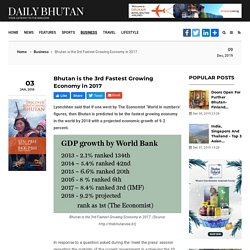
Bhutan is the 3rd Fastest Growing Economy in 2017. (Source: In response to a question asked during the ‘meet the press’ session regarding the inability of the current government in achieving the 10 percent growth rate targeted in its manifesto, the Prime Minister while acknowledging that it was not possible, said that actually a lot of progress had been achieved. Mangdechhu Hydroelectric Project, Mangdechhu River, Bhutan. The Mangdechhu hydroelectric project (HEPP) is a 720MW run-of-river power plant built on the Mangdechhu River in Trongsa Dzongkhag District, central Bhutan.

A part of the Indian Government and the Royal Government of Bhutan, Mangdechhu Hydroelectric Project Authority (MHPA) developed the project. Mangdechhu is one of the ten hydroelectric projects planned as part of the Royal Government of Bhutan’s initiative to generate 10GW of hydropower by 2020 with support from the Indian Government. The two governments signed an agreement for the construction of Mangdechhu HEPP at a cost of Rs28.96bn ($434m) in April 2010. The Indian Government funded the project through a 70% loan and a 30% grant. India approved a revised cost estimate of Rs40.20bn ($602.7m) for the project in 2016. Construction of the hydropower project began in June 2012. The project is estimated to generate 2,923GW/h of electricity and neutralise 2.2Mt of CO2 from the atmosphere every year. Bhutan is the 3rd Fastest Growing Economy in 2017 - Daily Bhutan - Your gateway to the Kingdom. How does Bhutan’s Economy Look?
Bhutan is one of the smallest, but fastest-growing economies in the world.
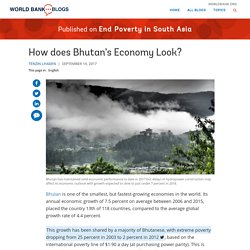
Its annual economic growth of 7.5 percent on average between 2006 and 2015, placed the country 13th of 118 countries, compared to the average global growth rate of 4.4 percent. This growth has been shared by a majority of Bhutanese, with extreme poverty dropping from 25 percent in 2003 to 2 percent in 2012 , based on the international poverty line of $1.90 a day (at purchasing power parity). This is among the rate in South Asia and compares favourably to the regional poverty rate of 19 percent. Equally impressive improvements were made in access to basic services such as health, education and asset ownership.
The recent developments on strong lending growth, inflation, exchange rates and international reserves show that Bhutan maintains a solid and stable growth in the first half of 2017. Despite recent solid growth and macroeconomic stability, we need to carefully monitor its Development. Bhutan’s economy and trade imbalance – KuenselOnline. Bhoutan : Un fonds fiduciaire intérieur pour la vaccination. Un fonds fiduciaire est un mécanisme permettant à un gouvernement de sanctuariser, ou protéger, des fonds destinés à une fin spécifique.
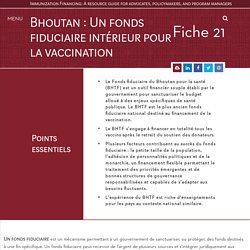
Un fonds fiduciaire peut recevoir de l’argent de plusieurs sources et s'intégrer juridiquement aux politiques et réglementations fiscales spécifiques de chaque pays ; un Conseil d'administration en supervise la stratégie, le montage financier, la gestion et le fonctionnement. Un fonds fiduciaire peut aussi compter des administrateurs qui cherchent à s'assurer du taux de rendement, du niveau de risque et du taux d'épuisement du capital. Les sources de revenu peuvent comprendre des taxes intérieures, des dons et des contributions privées (voir fiche 7.) Bhutan Energy 2018, CIA World Factbook. Lhaki Bhutan. Lhaki Cement. Bhoutan : le Premier ministre refuse le rapatriement des réfugiés du Népal. Népal - 100 000 réfugiés bhoutanais attendent de rentrer chez eux depuis quinze ans.
Dans les années 1990, le roi du Bhoutan, Jigme Singye Wangchuk, a lancé un programme de «bhoutanisation» du royaume himalayen et a expulsé ceux qui pour lui n’étaient pas de purs Bhoutanais.
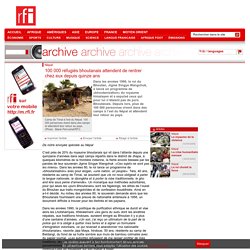
Depuis lors, plus de 100 000 personnes vivent dans des camps à l’est du Népal et attendent leur retour au pays. De notre envoyée spéciale au Népal C’est près de 20% du royaume bhoutanais qui vit dans l’attente depuis une quinzaine d’années dans sept camps répartis dans le district de Jhapa, à quelques kilomètres de la frontière indienne, la fierté encore blessée par les paroles de leur souverain Jigme Singye Wangchuk :«Ces sujets ne sont pas les miens». Dans les années 80, le roi lance un programme de «bhoutanisation» avec pour slogan, «une nation, un peuple». Tara, 40 ans, résidente au camp de Timai, se souvient que «le roi nous obligeait à parler la langue nationale, le dzongkha et à porter la robe traditionnelle, le gho and kira sous peine d’amende».
Location: This entry identifies the country's regional location, neighboring countries, and adjacent bodies of water.
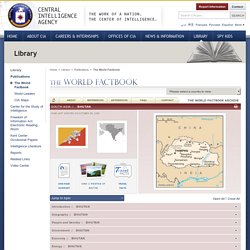
Southern Asia, between China and India Geographic coordinates: This entry includes rounded latitude and longitude figures for the centroid or center point of a country expressed in degrees and minutes; it is based on the locations provided in the Geographic Names Server (GNS), maintained by the National Geospatial-Intelligence Agency on behalf of the US Board on Geographic Names. Map references: This entry includes the name of the Factbook reference map on which a country may be found. Note that boundary representations on these maps are not necessarily authoritative. The entry on Geographic coordinates may be helpful in finding some smaller countries.
Area: This entry includes three subfields. This is the population pyramid for Bhutan. Asian Development Bank. Small0countrie00Botswana0and0Bhutan. 98089 Small Countries with Volatile Revenue: Botswana and Bhutan Naoko C.
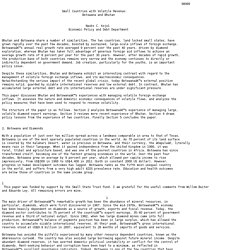
Kojo1 Economic Policy and Debt Department Bhutan and Botswana share a number of similarities. The two countries, land locked small states, have grown rapidly over the past few decades, boosted by sustained, large-scale inflows of foreign exchange. Botswana’s annual real growth rate averaged 9 percent over the past 40 years, driven by diamond exploration, whereas Bhutan has taken full advantage of generous foreign aid inflows to achieve an average growth rate of 8 percent per year for the past 30 years. However, after decades of rapid growth, the production base of both countries remains very narrow and the economy continues to directly or indirectly dependent on government demand.
Job creation, particularly for the youths, is an important policy issue. BT_e. Risque pays du Bhoutan : Commerce international - Objectif Import Export. Bhutan Land Of The Thunder Dragon: Our River of Hope. Ours has been a long, long journey of hope, and of optimism.
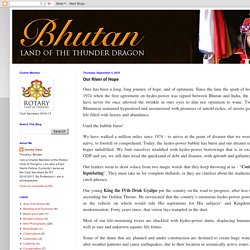
Since the time the spark of hope was ignited in 1974 when the first agreement on hydro-power was signed between Bhutan and India, the dream merchants have never for once allowed the twinkle in ours eyes to dim nor optimism to wane. Two generations of Bhutanese remained hypnotized and mesmerized with promises of untold riches, of streets paved in gold and a life filled with luxury and abundance. Until the bubble burst! We have walked a million miles since 1974 - to arrive at the point of disaster that we were too trusting and naïve, to foretell or comprehend. Today, the hydro-power bubble has burst and our dreams remain dashed and hopes unfulfilled. Le côté obscur de l’hydroélectricité au Bhoutan. Montagnes, rivières et ponts au Bhoutan.
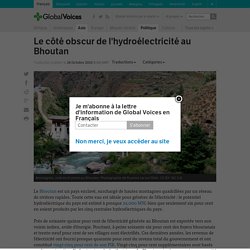
Photographie de Ryanne Lai sur Flickr. CC BY-NC 2.0.